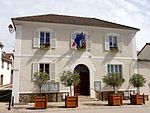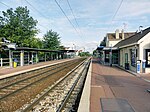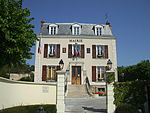Bouffémont - Moisselles station
Railway stations in France opened in 1877Railway stations in Val-d'OiseÎle-de-France railway station stubs

Bouffémont – Moisselles is a railway station in Bouffémont (Val d'Oise department), France and also serves nearby Moisselles. It is on the Épinay-Villetaneuse–Le Tréport-Mers railway, which connects the Paris agglomeration with the coastal resort Le Tréport via Beauvais. The station is served by Transilien suburban trains from the Gare du Nord in Paris to Persan-Beaumont and to Luzarches. The daily number of passengers was between 500 and 2,500 in 2002. The station has 150 parking spaces. The line from Épinay-Villetaneuse to Persan-Beaumont via Montsoult was opened by the Compagnie des chemins de fer du Nord (Nord Railway Company) in 1877.
Excerpt from the Wikipedia article Bouffémont - Moisselles station (License: CC BY-SA 3.0, Authors, Images).Bouffémont - Moisselles station
Rue Louise Michel, Sarcelles
Geographical coordinates (GPS) Address Nearby Places Show on map
Geographical coordinates (GPS)
| Latitude | Longitude |
|---|---|
| N 49.045277777778 ° | E 2.3227777777778 ° |
Address
Voie 1
Rue Louise Michel
95570 Sarcelles
Ile-de-France, France
Open on Google Maps









